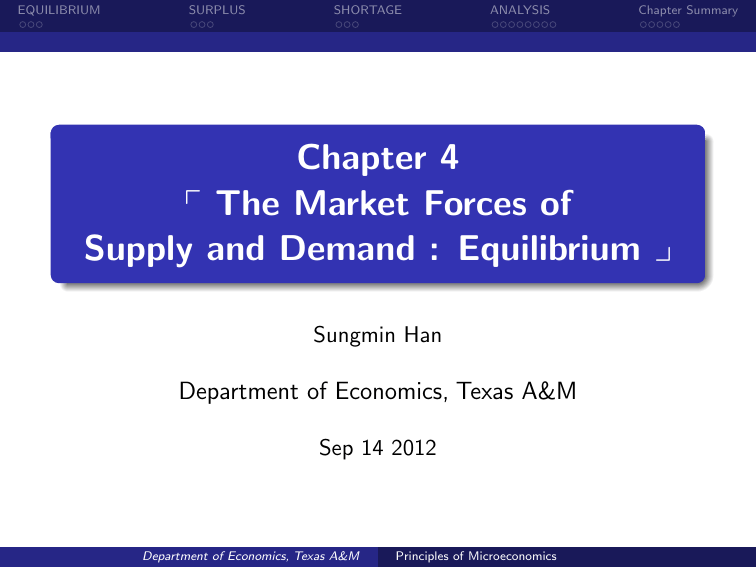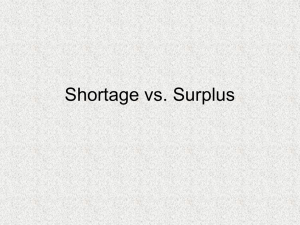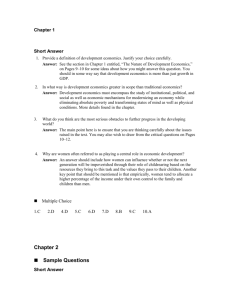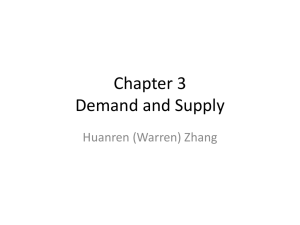Chapter 4 - Department of – Economics
advertisement

EQUILIBRIUM SURPLUS SHORTAGE ANALYSIS Chapter Summary Chapter 4 p The Market Forces of Supply and Demand : Equilibrium y Sungmin Han Department of Economics, Texas A&M Sep 14 2012 Department of Economics, Texas A&M Principles of Microeconomics EQUILIBRIUM SURPLUS SHORTAGE ANALYSIS Supply and Demand Together Figure 1: Supply and Demand Department of Economics, Texas A&M Principles of Microeconomics Chapter Summary EQUILIBRIUM SURPLUS SHORTAGE ANALYSIS Equilibrium Price the price that equates quantity supplied with quantity demanded Figure 2: Equilibrium Price Department of Economics, Texas A&M Principles of Microeconomics Chapter Summary EQUILIBRIUM SURPLUS SHORTAGE ANALYSIS Equilibrium Quantity the quantity supplied and quantity demanded at the equilibrium price Figure 3: Equilibrium Quantity Department of Economics, Texas A&M Principles of Microeconomics Chapter Summary EQUILIBRIUM SURPLUS SHORTAGE ANALYSIS Chapter Summary Surplus (Excess Supply) I When quantity supplied is greater than quantity demanded Example: If P = $5, then Q D = 9 lattes and Q S = 25 lattes resulting in a surplus of 16 lattes Figure 4: Excess Supply Department of Economics, Texas A&M Principles of Microeconomics EQUILIBRIUM SURPLUS SHORTAGE ANALYSIS Chapter Summary Surplus (Excess Supply) II When quantity supplied is greater than quantity demanded Facing a surplus, sellers try to increase sales by cutting price. This causes Q D to rise and Q S to fall . . ., . . . which reduces the surplus. Figure 5: Excess Supply Department of Economics, Texas A&M Principles of Microeconomics EQUILIBRIUM SURPLUS SHORTAGE ANALYSIS Chapter Summary Surplus (Excess Supply) III When quantity supplied is greater than quantity demanded Prices continue to fall until market reaches equilibrium. Figure 6: Excess Supply Department of Economics, Texas A&M Principles of Microeconomics EQUILIBRIUM SURPLUS SHORTAGE ANALYSIS Chapter Summary Shortage (Excess Demand) I When quantity demanded is greater than quantity supplied Example: If P = $1, then Q D = 21 lattes and Q S = 5 lattes resulting in a shortage of 16 lattes Figure 7: Excess Demand Department of Economics, Texas A&M Principles of Microeconomics EQUILIBRIUM SURPLUS SHORTAGE ANALYSIS Chapter Summary Shortage (Excess Demand) II when quantity demanded is greater than quantity supplied Facing a shortage, sellers raise the price, causing Q D to fall and Q S to rise which reduces the shortage. Figure 8: Excess Demand Department of Economics, Texas A&M Principles of Microeconomics EQUILIBRIUM SURPLUS SHORTAGE ANALYSIS Chapter Summary Shortage (Excess Demand) III when quantity demanded is greater than quantity supplied Prices continue to rise until market reaches equilibrium. Figure 9: Excess Demand Department of Economics, Texas A&M Principles of Microeconomics EQUILIBRIUM SURPLUS SHORTAGE ANALYSIS Chapter Summary Three Steps to Analyzing Changes in Equilibrium To determine the effects of any event, STEP 1. Decide whether event shifts S curve, D curve, or both. STEP 2. Decide in which direction curve shifts. STEP 3. Use supply-demand diagram to see how the shift changes Eq’m P and Q. Department of Economics, Texas A&M Principles of Microeconomics EQUILIBRIUM SURPLUS SHORTAGE ANALYSIS EXAMPLE : The Market for Hybrid Cars Figure 10: The Market for Hybrid Cars Department of Economics, Texas A&M Principles of Microeconomics Chapter Summary EQUILIBRIUM SURPLUS SHORTAGE ANALYSIS Chapter Summary EXAMPLE I : A Shift in Demand Increase in price of gas STEP 1: D curve shifts STEP 2: D shifts right STEP 3: The shift causes an increase in price and quantity of hybrid cars. Notice: When price rises, producers supply a larger quantity of hybrids, even though the S curve has not shifted. Always be careful to distinguish between a shift in a curve and a movement along the curve. Department of Economics, Texas A&M Principles of Microeconomics EQUILIBRIUM SURPLUS SHORTAGE ANALYSIS EXAMPLE I : A Shift in Demand [ Increase in price of gas ] Figure 11: A Shift in Demand Department of Economics, Texas A&M Principles of Microeconomics Chapter Summary EQUILIBRIUM SURPLUS SHORTAGE ANALYSIS Chapter Summary Terms for Shift vs. Movement Along Curve Change in supply: a shift in the S curve occurs when a non-price determinant of supply changes (like technology or costs) Change in the quantity supplied: a movement along a fixed S curve occurs when price changes Change in demand: a shift in the D curve occurs when a non-price determinant of demand changes (like income or # of buyers) Change in the quantity demanded: a movement along a fixed D curve occurs when price changes Department of Economics, Texas A&M Principles of Microeconomics EQUILIBRIUM SURPLUS SHORTAGE ANALYSIS Chapter Summary EXAMPLE II : A Shift in Supply New technology reduces cost of producing hybrid cars. STEP 1: S curve shifts STEP 2: S shifts right STEP 3: The shift causes price to fall and quantity to rise Figure 12: A Shift in Supply Department of Economics, Texas A&M Principles of Microeconomics EQUILIBRIUM SURPLUS SHORTAGE ANALYSIS Chapter Summary EXAMPLE III : A Shift in Both Supply and Demand price of gas rises AND new technology reduces production costs STEP 1: Both curves shift. STEP 2: Both shift to the right. STEP 3: Quantity rises, but effect on price is ambiguous. If demand increases more than supply, price rises. Figure 13: A Shift in Supply and Demand Department of Economics, Texas A&M Principles of Microeconomics EQUILIBRIUM SURPLUS SHORTAGE ANALYSIS Chapter Summary EXAMPLE III : A Shift in Both Supply and Demand price of gas rises AND new technology reduces production costs STEP 1: Both curves shift. STEP 2: Both shift to the right. STEP 3: But if supply increases more than demand, price falls. Figure 14: A Shift in Supply and Demand Department of Economics, Texas A&M Principles of Microeconomics EQUILIBRIUM SURPLUS SHORTAGE ANALYSIS Chapter Summary Summary: How Prices Allocate Resources One of the Ten Principles from Chapter 1: Markets are usually a good way to organize economic activity. In market economies, prices adjust to balance supply and demand. These equilibrium prices are the signals that guide economic decisions and thereby allocate scarce resources. Department of Economics, Texas A&M Principles of Microeconomics EQUILIBRIUM SURPLUS SHORTAGE ANALYSIS Chapter Summary Summary A competitive market has many buyers and sellers, each of whom has little or no influence on the market price. Economists use the supply and demand model to analyze competitive markets. The downward-sloping demand curve reflects the Law of Demand, which states that the quantity buyers demand of a good depends negatively on the good’s price. Department of Economics, Texas A&M Principles of Microeconomics EQUILIBRIUM SURPLUS SHORTAGE ANALYSIS Chapter Summary Summary Besides price, demand depends on buyers’ incomes, tastes, expectations, the prices of substitutes and complements, and number of buyers. If one of these factors changes, the D curve shifts. The upward-sloping supply curve reflects the Law of Supply, which states that the quantity sellers supply depends positively on the good’s price. Other determinants of supply include input prices, technology, expectations, and the # of sellers. Changes in these factors shift the S curve. Department of Economics, Texas A&M Principles of Microeconomics EQUILIBRIUM SURPLUS SHORTAGE ANALYSIS Chapter Summary Summary The intersection of S and D curves determines the market equilibrium. At the equilibrium price, quantity supplied equals quantity demanded. If the market price is above equilibrium, a surplus results, which causes the price to fall. If the market price is below equilibrium, a shortage results, causing the price to rise. Department of Economics, Texas A&M Principles of Microeconomics EQUILIBRIUM SURPLUS SHORTAGE ANALYSIS Chapter Summary Summary We can use the supply-demand diagram to analyze the effects of any event on a market: First, determine whether the event shifts one or both curves. Second, determine the direction of the shifts. Third, compare the new equilibrium to the initial one. In market economies, prices are the signals that guide economic decisions and allocate scarce resources. Department of Economics, Texas A&M Principles of Microeconomics









